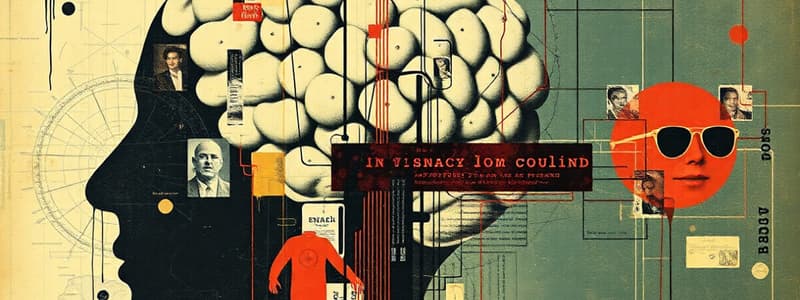Podcast
Questions and Answers
What happens to the B process in response to repeated exposure to the A process?
What happens to the B process in response to repeated exposure to the A process?
- It remains unchanged.
- It becomes shorter lasting.
- It decreases in magnitude.
- It increases in magnitude and duration. (correct)
In the context of addiction, what describes the effects of the B process?
In the context of addiction, what describes the effects of the B process?
- They are the opposite of the A process. (correct)
- They cause pleasure.
- They promote relaxation.
- They are the same as the A process.
What happens during the withdrawal phase of addiction?
What happens during the withdrawal phase of addiction?
- The A process strengthens.
- The B process becomes less prominent.
- The A process remains unaltered.
- The B process effects dominate. (correct)
Which part of the brain is primarily associated with the binge/intoxication stage of addiction?
Which part of the brain is primarily associated with the binge/intoxication stage of addiction?
How does the A process change with the development of tolerance in addiction?
How does the A process change with the development of tolerance in addiction?
What is indicated by fewer D2 receptors in relation to drug use?
What is indicated by fewer D2 receptors in relation to drug use?
Which brain region is primarily involved in habit formation related to drug cue associations?
Which brain region is primarily involved in habit formation related to drug cue associations?
During the craving phase of addiction, which system is activated alongside the limbic system?
During the craving phase of addiction, which system is activated alongside the limbic system?
What characterizes the hypofrontality observed in individuals with drug addiction?
What characterizes the hypofrontality observed in individuals with drug addiction?
What is the mechanism through which antagonist treatments work in addiction?
What is the mechanism through which antagonist treatments work in addiction?
In the context of pharmacotherapy for addiction, how do partial agonist treatments function?
In the context of pharmacotherapy for addiction, how do partial agonist treatments function?
What is the primary purpose of antidrug vaccines in addiction treatment?
What is the primary purpose of antidrug vaccines in addiction treatment?
Which treatment involves inducing a negative reaction to discourage drug use?
Which treatment involves inducing a negative reaction to discourage drug use?
Flashcards
Opponent Process Theory
Opponent Process Theory
A theory stating that a stimulus's initial effect (A process) is followed by an opposing effect (B process) that increases in strength with repeated exposure.
A process
A process
The initial physiological response of the brain to a stimulus.
B process
B process
The opposing response to initial stimulus, increasing in strength with repeated use.
Tolerance (Addiction)
Tolerance (Addiction)
Signup and view all the flashcards
Withdrawal (Addiction)
Withdrawal (Addiction)
Signup and view all the flashcards
Incentive Salience
Incentive Salience
Signup and view all the flashcards
Habit Formation
Habit Formation
Signup and view all the flashcards
Withdrawal/Negative Affect Stage
Withdrawal/Negative Affect Stage
Signup and view all the flashcards
Agonist Treatments
Agonist Treatments
Signup and view all the flashcards
Partial Agonist Treatments
Partial Agonist Treatments
Signup and view all the flashcards
Antagonist Treatments
Antagonist Treatments
Signup and view all the flashcards
Aversive Treatments
Aversive Treatments
Signup and view all the flashcards
Antidrug Vaccines
Antidrug Vaccines
Signup and view all the flashcards
Study Notes
Opponent Process Theory
- Explains how responses to a stimulus (A process) trigger an opposing process (B process).
- The B process increases in magnitude and duration with repeated exposure.
- A process weakens, and B process strengthens.
Opponent Process Theory Applied to Addiction
- Tolerance develops as the A process adapts (metabolic, pharmacodynamic, or behavioral).
- Withdrawal arises from a stronger B process.
- A process effects are the opposite of B process effects.
- Example: Alcohol's A process (relaxation/anxiety relief) and B process (anxiety).
The Brain Disease Model of Addiction: Stages & Circuitry
-
Binge/Intoxication Stage:
- Basal Ganglia (striatum) and reward pathway are activated.
- Drug exposure initially releases dopamine in the reward pathway.
- Reward deficiency hypothesis: Individuals with fewer D2 receptors may experience more pleasure from stimulants.
- Incentive salience: Drug/cue associations form, leading to habit formation in the basal ganglia.
- Dopamine is released in response to cues, not the drug itself.
-
Withdrawal/Negative Affect Stage:
- Limbic system (amygdala) and stress system (HPA axis) activated.
- "Anti-reward" or "Dark Side" develops.
- The reward pathway becomes desensitized to natural rewards.
- Brain stress systems and amygdala cause negative mood.
-
Preoccupation/Anticipation Stage:
- Prefrontal cortex (PFC), stress system (HPA axis), basal ganglia, and insula involved.
- Executive function impairment due to hypofrontality.
- PFC experiences desensitization to natural rewards but sensitization to drug cues.
- Insula sensitive to cravings (interoception).
- Stress system and basal ganglia habit formation remain active.
Pharmacotherapy of Addiction
- Agonist Treatments: Replace the addictive drug with a similar-acting drug.
- Examples: Methadone for heroin, nicotine patch for cigarettes.
- Partial Agonist Treatments: Prevent withdrawal and cravings with a drug offering a partial effect.
- Example: Varenicline (Chantix) for nicotine addiction (partial nAch receptor agonist).
- Antagonist Treatments: Block the effects of the addictive drug.
- Example: Naloxone for heroin (competitive mu receptor agonist).
- Aversive Treatments: Induce a negative reaction when the addictive drug is taken.
- Example: Disulfiram (Antabuse) for alcohol.
- Example: Suboxone (buprenorphine + naloxone) for opioids.
- Antidrug Vaccines: Inject synthetic molecules similar to the drug.
- Immune system creates antibodies to decrease drug brain absorption.
Studying That Suits You
Use AI to generate personalized quizzes and flashcards to suit your learning preferences.
Description
This quiz explores the Opponent Process Theory and its application to addiction, detailing how stimulus responses trigger opposing processes. It also examines the brain circuitry involved in addiction, specifically during the binge/intoxication stage and the effects of dopamine release.



